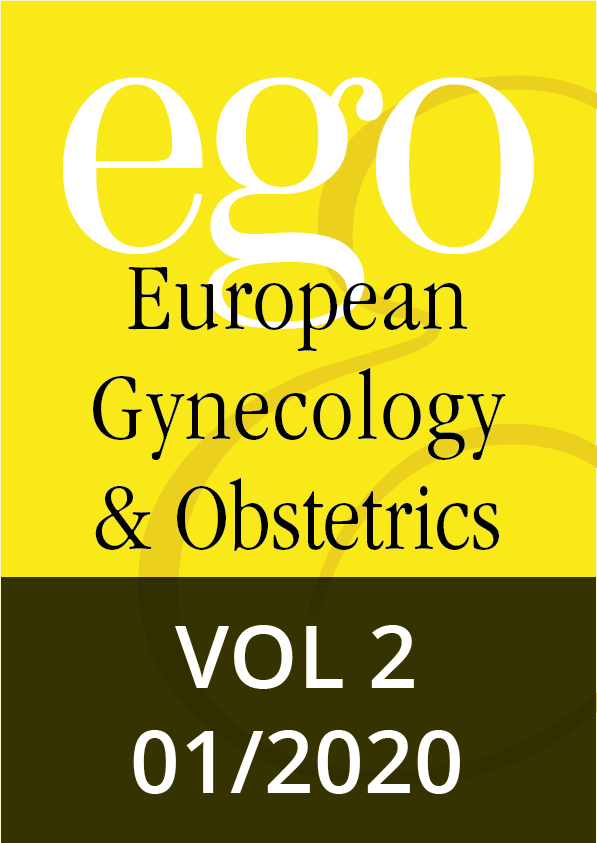Short reviews, 005–009 | DOI: 10.53260/EGO.202012
Short reviews, 016–021 | DOI: 10.53260/EGO.202014
Systematic review, 022–029 | DOI: 10.53260/EGO.202015
Systematic review, 030–035 | DOI: 10.53260/EGO.202016
Original articles, 036–041 | DOI: 10.53260/EGO.202017
Original articles, 042–046 | DOI: 10.53260/EGO.202018
Original articles, 047–049 | DOI: 10.53260/EGO.202019
Original articles, 050–055 | DOI: 10.53260/EGO.2020110
Original articles, 056–061 | DOI: 10.53260/EGO.2020111
Original articles, 062–067 | DOI: 10.53260/EGO.2020112
Adverse effect of higher waist circumference in assisted reproductive technology outcomes
Abstract
Background and purpose: Studies on the influence of obesity on the outcomes of treatment with assisted reproductive technologies (ART) are contradictory, although most have demonstrated a negative impact. The contribution of abdominal obesity, an effective marker of dysfunctional adipose tissue, has been poorly investigated.|
Methods: Observational cohort study. All women (N=578) who underwent ART treatment at the fertility centre of a Portuguese University Hospital during the study period were included. The women’s body mass index (BMI) and waist circumference (WC) were evaluated at the beginning of the stimulation cycle. They underwent controlled ovarian hyperstimulation with long agonist or short antagonist/agonist protocols. Data were stratified in two groups, according to the women’s WC-based metabolic risk (defined according to Portuguese national guidelines): lower metabolic risk (WC < 88 cm) and higher metabolic risk (WC ≥ 88 cm).|
Results: The women with a WC < 88 cm had a higher number of oocytes collected (≈ 8% more, p=0.049), a higher number of mature oocytes (≈ 20% more, p=0.010), a higher number of fertilized oocytes (≈ 28 more, p=0.017) and a lower gonadotropin requirement (≈ 10% less, p=0.042) than the women with a WC ≥ 88 cm. The chance of fertilization occurring was two times higher in women with a WC < 88 cm (OR [95% CI]:2.04 [1.04-4.00]). No significant associations were observed between WC group and pregnancy, live birth, cycle cancellation and miscarriage rates.|
Conclusions: Women with a higher WC have poorer ART treatment outcomes, namely a lower number of oocytes collected, a lower number of mature oocytes, and a lower number of fertilized oocytes. This study highlights the importance of considering fat distribution in the quest to clarify the impact of obesity on ART treatment outcomes. According to our results, women with a WC ≥ 88 cm have poorer outcomes. It would be important to consider women’s fat distribution when counseling and predicting ART treatment outcomes, particularly in terms of ovarian stimulation and oocyte quality.
Keywords: Abdominal obesity, assisted reproductive technologies, body mass index, in vitro fertilization.
Citation: Ferreira A.,Paula Sousa A.,Moura-Ramos M.,Cortesão P.,Luísa Costa A.,Almeida Santos T., Adverse effect of higher waist circumference in assisted reproductive technology outcomes, EGO European Gynecology and Obstetrics (2020); 2020/01:036–041 doi: 10.53260/EGO.202017
Published: January 1, 2020
ISSUE 2020/01

Short reviews, 005–009 | DOI: 10.53260/EGO.202012
Short reviews, 016–021 | DOI: 10.53260/EGO.202014
Systematic review, 022–029 | DOI: 10.53260/EGO.202015
Systematic review, 030–035 | DOI: 10.53260/EGO.202016
Original articles, 036–041 | DOI: 10.53260/EGO.202017
Original articles, 042–046 | DOI: 10.53260/EGO.202018
Original articles, 047–049 | DOI: 10.53260/EGO.202019
Original articles, 050–055 | DOI: 10.53260/EGO.2020110
Original articles, 056–061 | DOI: 10.53260/EGO.2020111
Original articles, 062–067 | DOI: 10.53260/EGO.2020112
